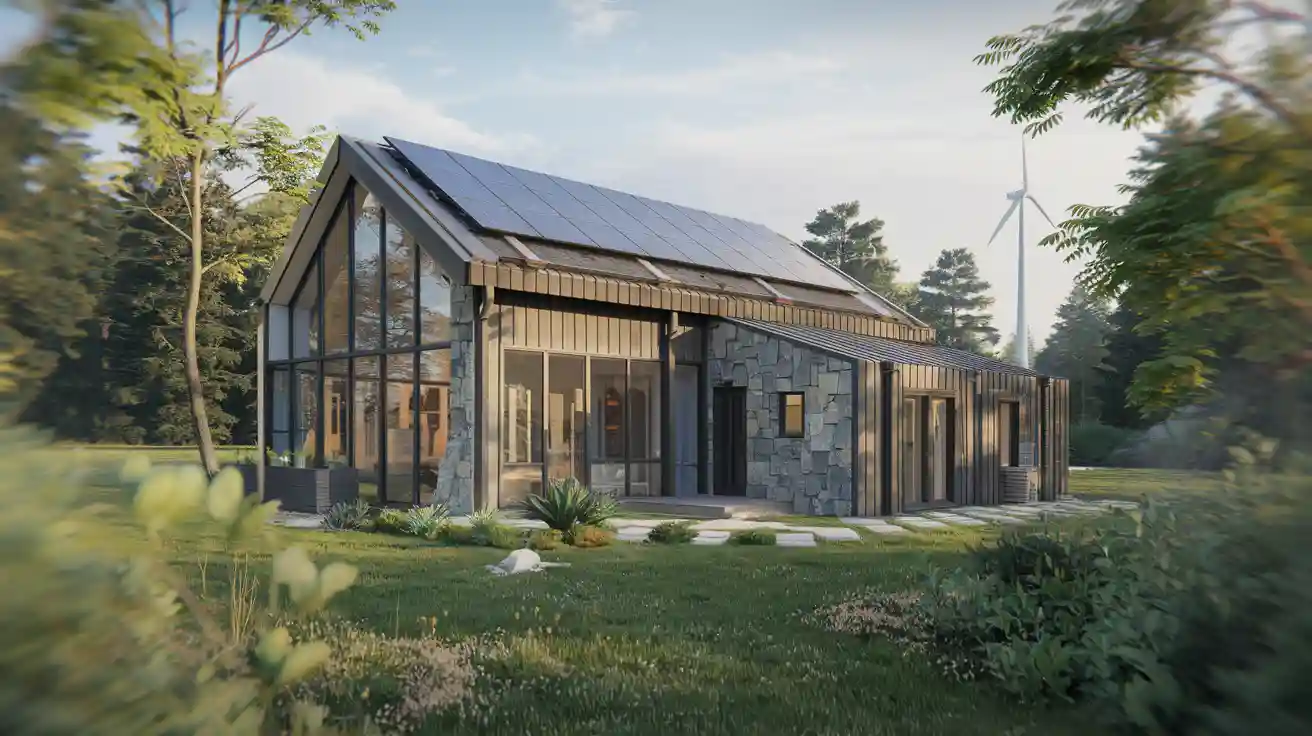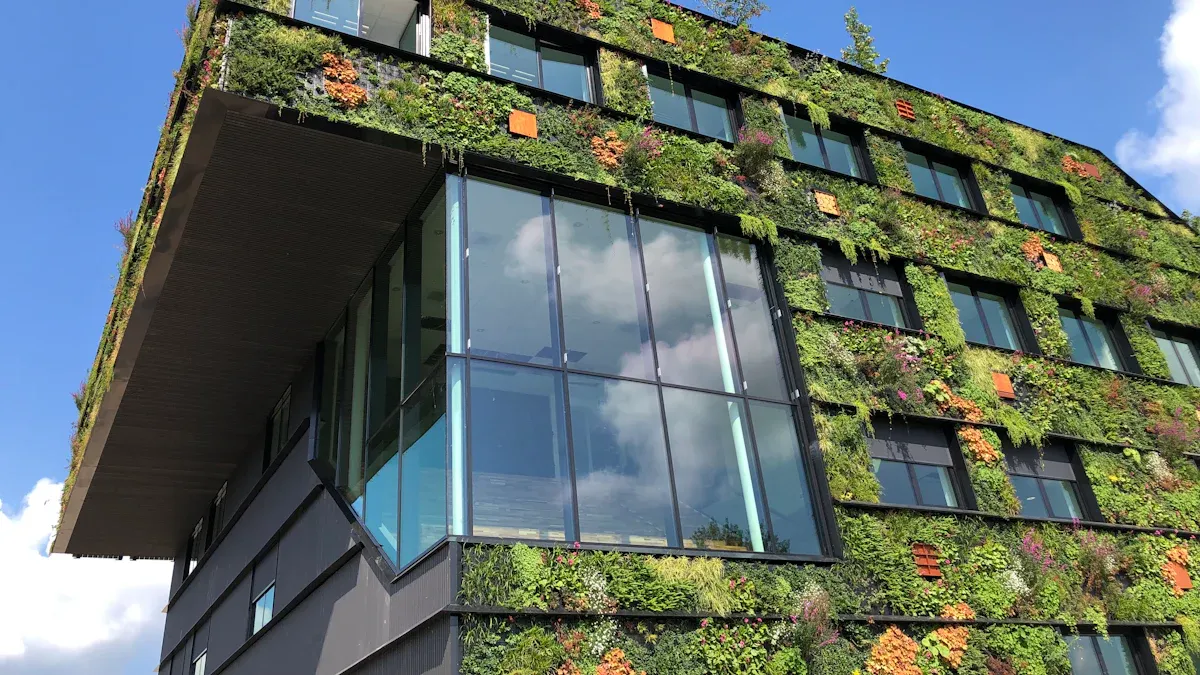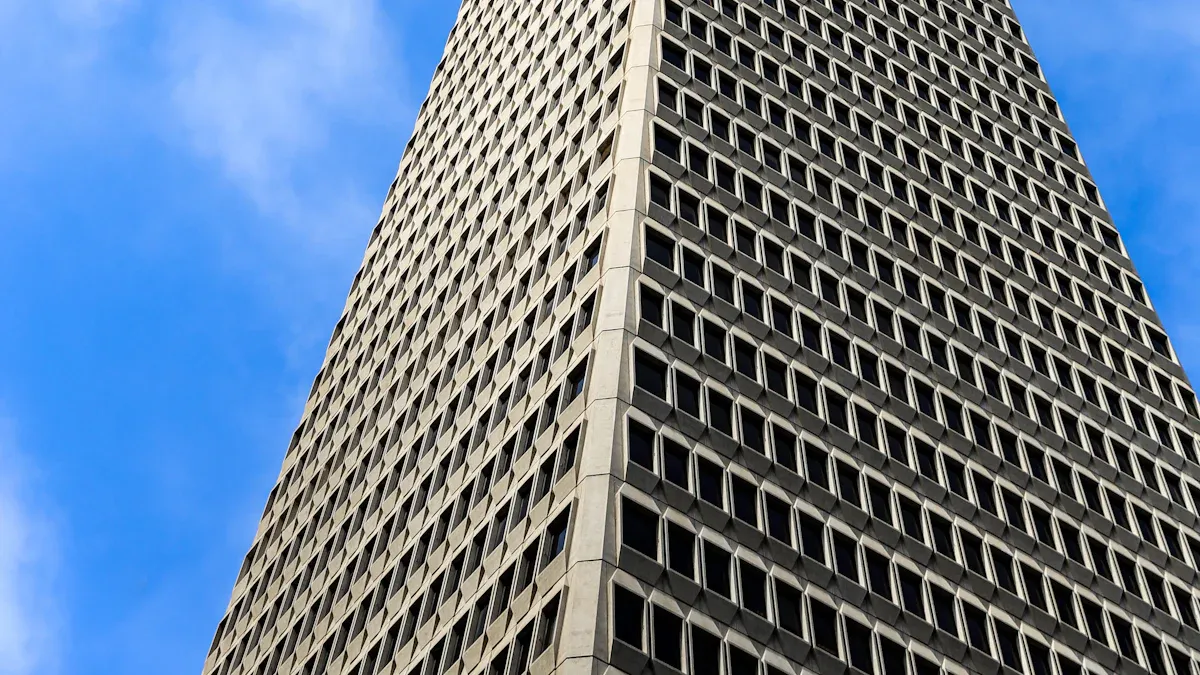Key Trends in Energy-efficient and Resilient Home Construction

The demand for eco-friendly homes is rapidly increasing, with many individuals prioritizing energy efficiency and environmental sustainability. Approximately 84% of people believe that living in a green home is essential, and 64% are willing to invest more in eco-friendly neighborhoods. These preferences are shaping Construction and Remodeling Trends 2025, influencing how homes are designed and updated. Builders are adopting innovative approaches to meet these demands. Advanced technologies like AI and IoT are enhancing both safety and sustainability in construction. Tools such as Autodesk Construction IQ and Triax Technologies’ Spot-R clip are prime examples of how construction is becoming smarter and safer. If you're a contractor, list your business in our directory to connect with clients seeking strong, sustainable, and modern homes.
Key Takeaways
Green homes are very popular. Using materials like old wood and bamboo helps the planet.
Homes that save energy, like net-zero and passive homes, cut bills and feel better to live in. Use good insulation and energy-saving windows.
Strong features, like raised floors and tough glass, keep homes safe in bad weather. These can also lower insurance costs.
Smart tools, like energy systems and smart gadgets, save power and make life easier. Start with things like smart thermostats.
Modular homes are fast and eco-friendly to build. They make less waste and can be made to fit your style.
Sustainable Materials and Eco-friendly Practices

Popular Sustainable Materials
Reclaimed wood and recycled steel
Using reclaimed wood and recycled steel helps protect the environment. These materials reduce the need to cut down new trees. This keeps forests healthier and safer. Reclaimed wood is strong and lasts a long time. Recycled steel cuts down on trash and supports greener choices. By picking these materials, you help the planet and build a sturdy home.
Hempcrete, bamboo, cork, and composite decking
Hempcrete and bamboo are great for lowering carbon emissions. Bamboo can remove about 250 kg of CO2 per cubic meter used. Hempcrete absorbs over 22 tonnes of CO2 per hectare each year. Cork and composite decking are also smart picks. They are strong, renewable, and look great in eco-friendly designs.
Material | Carbon Reduction Potential |
|---|---|
Bamboo | Removes about 250 kg of CO2 per cubic meter used. |
Hempcrete | Absorbs over 22 tonnes of CO2 per hectare yearly. |
Benefits of Sustainable Materials
Reduced deforestation and carbon footprint
Choosing green materials helps save trees and lowers carbon emissions. Reclaimed wood and bamboo protect nature and reduce harm to the planet. This choice helps create a cleaner world for the future.
Biodegradability and improved affordability
Eco-friendly materials often break down naturally, reducing waste. While they may cost more at first, they save money over time. Green homes with energy-saving systems lower bills, making them a smart investment.
Eco-friendly Construction Practices
Repurposing existing buildings for new uses
Reusing old buildings is a creative way to go green. It cuts down on waste and saves resources. This method also keeps the charm and history of older places alive.
Water-saving fixtures and drought-resistant landscaping
Adding water-saving fixtures and drought-friendly plants makes your home greener. These features use less water and lower bills. They also help homes stay eco-friendly in dry areas.
Tip: Small steps, like using reclaimed wood or saving water, can make your home more eco-friendly.
Energy-efficient Design Innovations
Net-Zero and Passive Homes
High-performance insulation and energy-efficient windows
Net-zero and passive homes use less energy and stay cozy. They have strong insulation and special windows to keep temperatures steady. Insulation traps heat inside during winter and blocks it in summer. This reduces the need for heaters or air conditioners. Switching to passive house windows can cut energy use by 20-30%. These windows also let in lots of sunlight, making rooms bright and welcoming. They are tough and last for years, making them a great choice for saving energy.
Feature | Description |
|---|---|
Stops air leaks, improving energy savings. | |
Elimination of thermal bridging | Keeps home temperatures steady and comfortable. |
High-performance energy-efficient windows | Saves energy and brings in natural light. |
Thick and continuous insulation | Holds heat well, lowering energy bills. |
Renewable energy | Solar or wind power helps homes use less grid energy. |
Solar energy systems and their benefits
Solar energy systems are key in net-zero homes. They use sunlight to create power for your house. Solar panels help you depend less on regular electricity and save money. Using solar energy also supports green projects and helps the planet.
Advanced HVAC Systems
Drivers like rising energy costs and unpredictable weather
Energy prices are going up, and weather is changing. This makes advanced HVAC systems important. These systems adjust to keep you comfy and save energy.
Energy-efficient heating and cooling solutions
Modern HVAC systems include ductless mini-splits and heat pump water heaters. Motors with variable speeds use only the energy needed, saving power. Smart thermostats let you change settings from anywhere, using less energy. Better air filters clean the air, making homes healthier and more efficient.
Energy-efficient Fixtures
Smart lighting and appliances
Smart lights and appliances use less power and are easy to control. You can manage them with apps or voice commands. They make homes greener and smarter.
Compliance with environmental regulations and incentives
Energy-saving fixtures help meet environmental rules. Governments often give rewards for using these technologies. This makes it easier to invest in eco-friendly options.
Tip: Small upgrades, like better HVAC systems or solar panels, can greatly improve your home's energy efficiency.
Structures Resilient to Disasters

Disaster-resistant Structural Features
Raised foundations in flood-prone areas
Living in a flood zone? Raised foundations can help. They lift your home above floodwaters during storms. This design keeps your house safe and reduces water damage. It also gives you peace of mind during heavy rains.
Impact-resistant glass and hurricane straps
Impact-resistant glass stops windows from breaking during storms. It blocks flying debris and keeps your family safe. Hurricane straps hold the roof tightly to the walls. This lowers the chance of the roof blowing off. Together, these features make homes stronger against bad weather.
Pro Tip: Use insulated concrete forms (ICFs) for walls. They resist earthquakes and save energy, making them a smart pick.
Regional Adaptations
Earthquake-resistant designs on the West Coast
Earthquakes happen often on the West Coast. Flexible materials and strong foundations help homes stay safe. The "yakisugi" method protects cedar wood from pests, fire, and rot. Double-sealed windows add extra water protection. These features keep homes sturdy and energy-efficient during quakes.
Hurricane-proofing in coastal regions
Coastal homes face hurricanes and strong winds. Fire-resistant roofs and steel siding lower fire risks during storms. Reflective roof coatings block harmful sun rays and save energy. These upgrades make homes safer and more eco-friendly.
Federal Support and Incentives
FEMA and HUD programs for disaster-resilient homes
Federal programs help make homes stronger against disasters. FEMA gives funds to add safety features to your house. HUD’s program improves energy efficiency and resilience in assisted housing.
Insurance benefits for resilient designs
Adding disaster-resistant features can lower insurance costs. Insurers reward homeowners who protect their homes. Upgrades like hurricane straps or fireproof materials save money and improve safety.
Did You Know? SBA disaster loans can increase by 20% for safety upgrades. This helps you afford protective features for your home.
Integration of Smart Technologies
AI and IoT in Home Design
Energy management systems and smart lighting
Think of a home that saves energy on its own. Energy management systems use AI and IoT to make this happen. They lower energy use, cutting bills and helping the planet. Smart lighting lets you change brightness and colors with apps or voice. This makes your home comfy, stylish, and eco-friendly.
Did You Know? Smart lighting uses up to 75% less energy than regular bulbs.
AI-powered security and thermal comfort solutions
AI security systems keep your home safe by watching in real-time. They know the difference between real threats and harmless movements. This means fewer false alarms. AI also learns how you like your home’s temperature. It adjusts heating or cooling to keep you cozy. These tools make homes safer and more comfortable.
Digital Transformation in Construction
BIM for efficient planning and design
BIM, or Building Information Modeling, is changing construction. It helps teams work together better and avoid mistakes. BIM spots problems early, saving time and money. It also helps builders use materials wisely, reducing waste and supporting green practices.
Drones and robotics for safety and efficiency
Drones and robots are making construction safer and faster. Drones give aerial views to manage sites better. Robots handle tough or boring tasks with great accuracy. These tools keep workers safe and make building homes easier.
Smart Home Features
Voice-activated assistants and app-controlled appliances
Voice helpers like Alexa or Google Home make life simple. You can control gadgets, set alarms, or play music by talking. App-controlled devices let you manage your home from anywhere, adding even more convenience.
Circadian lighting and air purification systems
Circadian lighting changes during the day to match your body’s rhythm. This helps you feel better and stay focused. Air purifiers clean indoor air, keeping your family healthy. These features make your home a happier and healthier place.
Tip: Try starting with a smart thermostat or lighting system to see how a connected home works.
Future Trends and Challenges in Construction and Remodeling Trends 2025
Modular and Prefabricated Homes
Factory-made parts for quicker building
Modular homes are changing how houses are built. These homes use factory-made parts, speeding up the process. Building offsite and preparing onsite happen at the same time. This method cuts delays, so you can move in sooner.
Advantage | Description |
|---|---|
Sustainability | |
Efficiency | Faster building by combining offsite and onsite work. |
Quality | Factory-made parts ensure better and stronger homes. |
Affordable and flexible housing options
These homes save money by cutting waste and work time. They are also easy to customize to match your style and needs. Modular homes are a smart and budget-friendly choice for today’s homeowners.
Tip: Modular homes are strong and safe, especially in areas with natural disasters. They are both eco-friendly and durable.
Smaller, Sustainable Homes
Advantages of small designs and fewer materials
Smaller homes are becoming more popular. They use fewer materials, which saves money and helps the planet. These homes are easier to clean and heat, making them energy-efficient and practical.
Green features like bamboo and solar power
Adding bamboo and solar panels makes these homes eco-friendly. Bamboo grows fast and absorbs lots of CO2. Solar panels provide clean energy. Together, they make small homes greener and cheaper to run.
Did You Know? Small, well-planned homes save energy and lower your impact on the environment.
Balancing Sustainability and Resilience
Problems with cost and availability
Making homes both green and strong can be hard. High material prices and fewer workers make building affordable homes tough. Homes also need to handle extreme weather, adding more challenges.
New ideas to solve money and eco issues
Innovations are helping builders overcome these problems. They use advanced materials and methods to make homes green and strong. Modular homes, for example, cut waste by 75% and lower emissions by 30%. This makes them a big step forward in homebuilding.
Pro Tip: Choosing green and strong homes helps the planet and increases your home’s value and safety.
The future of building homes focuses on saving energy and staying strong during disasters. These ideas keep homes safe and help people stay healthy. Using eco-friendly methods also helps neighborhoods grow and fight climate change.
Green homes have many advantages:
They are popular with buyers and raise home prices.
Builders earn trust and get rewards for eco-friendly work.
Saving energy and water makes up for higher starting costs.
Start making greener choices today. Pick materials and designs that are both strong and eco-friendly. Together, we can create homes that last and inspire. 🌱
FAQ
What are the benefits of building an energy-efficient home?
Energy-efficient homes lower utility bills and help the environment. They improve air quality and make your home more comfortable. Choosing energy-efficient designs helps the planet and ensures a better future for your family. 🌍
How can I make my home more disaster-resilient?
Begin with upgrades like strong windows or hurricane straps. Raised foundations are useful in flood areas. Federal programs like FEMA grants can help pay for these changes. These upgrades protect your home and keep you safer during bad weather.
Are modular homes a good investment?
Yes! Modular homes save money, are eco-friendly, and can be customized. They are built with factory-made parts, which reduce waste and speed up building. These homes are strong and handle disasters well, making them a great choice for sustainable living.
Do smart technologies really save energy?
Yes! Smart thermostats, lights, and appliances use energy wisely. They adjust to your habits, cutting down on waste. For example, smart lights use 75% less energy than regular bulbs. These tools make your home greener and life easier. 💡
Can I afford sustainable materials for my home?
Sustainable materials might cost more at first but save money later. Materials like reclaimed wood and bamboo are strong and eco-friendly. Governments often give rewards for green building, making it easier to afford sustainable choices.
Tip: Start small by picking one or two green upgrades that fit your budget.
See Also
Innovative Roofing Ideas for Contemporary Residences
Cutting-Edge Home Security Developments Expected in 2025
Leading Window Upgrade Trends to Watch in 2025
Essential Pool Care Strategies for the Year 2025
Remarkable Foundation Restoration Success Stories in Los Angeles
